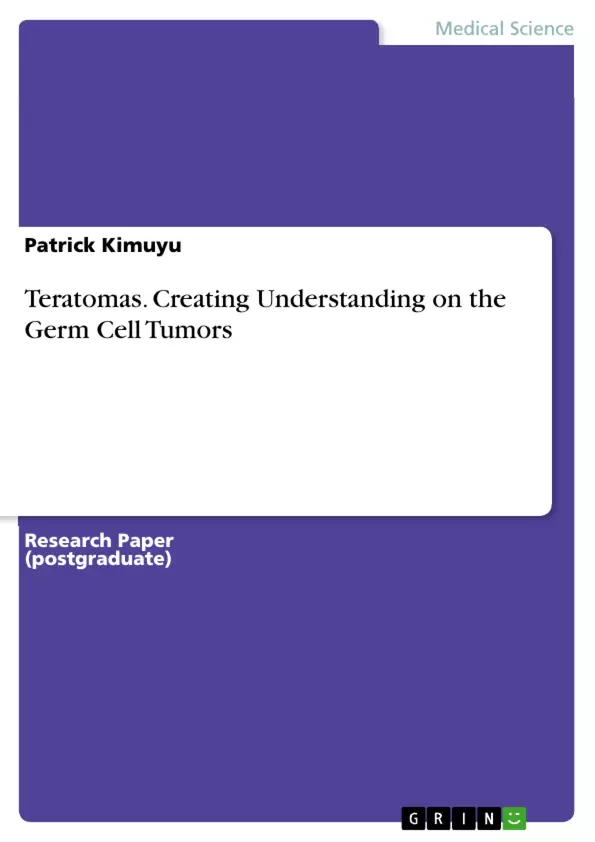In theory, teratomas are usually germ cell tumors that affect the germ layers. They occur as benign and malignant tumor growths in which some teratomas are highly specialized. This implies that, highly specialized teratomas are located with one germ layer; thus referred to as monodermal teratomas, whereas others occur with two or three germ layers. As such, these teratomas are classified as trigerminal because they can affect any of the three germ layers. For instance, dermoids are a group of teratomas that are recognized as trigerminal because they can occur in any of the germ layers of many tissues.
It is worth noting that teratomas begin as benign swellings and undergo transformation to become malignant. In practice, dermoids have been found to exhibit an orderly arrangement in which endodermal components are surrounded by well-differentiated mesodermal and ectodermal tissues. However, solid teratomas do not exhibit a high degree of cellular organization and differentiation.
Therefore, this paper will provide an overview of teratomas. It will discuss their causes, pathophysiology, clinical diagnosis and treatment, in order to create an overall understanding on these tumors.
Inhaltsverzeichnis (Table of Contents)
- Introduction
- Causes of Teratomas
- Pathophysiology of Teratomas
- Classification of Teratomas
- Sacrococcygeal Teratomas
- Ovarian Teratomas
- Testicular Teratomas
- Mediastinal Teratomas
- Diagnosis for Teratomas
- Treatment for Teratomas
Zielsetzung und Themenschwerpunkte (Objectives and Key Themes)
This paper aims to provide a comprehensive understanding of teratomas, a type of germ cell tumor affecting the germ layers. It will discuss the causes, pathophysiology, clinical diagnosis, and treatment of teratomas.
- Origin and development of teratomas from primordial germ cells.
- Anatomical and biological characteristics of teratomas, including their distribution and impact on different tissues.
- Classification of teratomas based on their location in the body.
- Diagnostic approaches for identifying teratomas, including physical examination, imaging techniques, and blood tests.
- Treatment options for teratomas, focusing on chemotherapy and surgical interventions.
Zusammenfassung der Kapitel (Chapter Summaries)
- Introduction: Introduces teratomas as germ cell tumors affecting germ layers, highlighting their potential for both benign and malignant growth. It emphasizes the classification of teratomas based on the number of germ layers involved, particularly mentioning trigerminal teratomas like dermoids.
- Causes of Teratomas: Examines the cause of teratomas as linked to meiotic embryonic cell divisions, particularly focusing on the parthenogenic theory. The theory suggests that teratomas originate from primordial germ cells and their migration from the yolk sac to other tissues. The correlation between teratomas and certain cancers, including acute myelogenous leukemia, is also highlighted.
- Pathophysiology of Teratomas: Discusses the anatomical and biological characteristics of teratomas, explaining their composition of parenchymal cell types from the three germ layers. The paper highlights the common locations of teratomas, including the sacrococcygeal region, gonads, mediastinum, and retroperitoneal areas. It also mentions the diverse tissue types affected by teratomas, such as skin, teeth, muscle, fat, hair, and endocrine tissues.
- Classification of Teratomas: Presents the four main types of teratomas based on their location: sacrococcygeal, ovarian, testicular, and mediastinal teratomas. Each type is briefly described, highlighting their prevalence and characteristics.
- Sacrococcygeal Teratomas: Explores the most prevalent type of teratomas, diagnosed during prenatal periods. It discusses the common signs of sacrococcygeal teratomas, including tumor hemorrhage and polydramnios. The significant implications of hydrops fetalis, particularly during the first and second trimesters, are also emphasized.
- Ovarian Teratomas: Describes the characteristics of ovarian teratomas, including anemia and potential complications like torsion, malignant degeneration, infection, and rupture. It mentions that mature ovarian teratomas are typically benign.
- Testicular Teratomas: Explains that testicular teratomas are predominantly benign, occurring mostly in infants and children. The paper highlights the potential for metastasis in adults, affecting retroperitoneal lymph nodes and other systems.
- Mediastinal Teratomas: Discusses mediastinal teratomas, similar to testicular teratomas in their benign nature but distinct in their anatomical location. It explains that mediastinal teratomas affect the mediastinum and can impact other intrathoracic structures during complications.
- Diagnosis for Teratomas: Outlines the diagnostic approaches used for identifying teratomas, including physical examination, scanning techniques (chest X-ray and CT scans), and blood tests. It emphasizes the importance of blood tests for determining levels of proteins associated with teratomas, such as alpha-fetoprotein (AFP) and beta-hCG. The paper also mentions the use of core biopsy or fine-needle aspiration for differentiating benign and malignant teratomas.
- Treatment for Teratomas: Explains the two primary treatment options for teratomas: chemotherapy and surgery. It discusses the use of cytotoxic agents in chemotherapy to treat the tumor and prevent its spread. Surgical options, including cystectomy, complete excision, and radical orchiectomy, are described, highlighting the importance of testis-sparing techniques for testicular teratomas.
Schlüsselwörter (Keywords)
Germ cell tumors, teratomas, germ layers, primordial germ cells, parthenogenic theory, sacrococcygeal teratomas, ovarian teratomas, testicular teratomas, mediastinal teratomas, hydrops fetalis, diagnosis, treatment, chemotherapy, surgery.
- Quote paper
- Patrick Kimuyu (Author), 2017, Teratomas. Creating Understanding on the Germ Cell Tumors, Munich, GRIN Verlag, https://www.grin.com/document/385081



